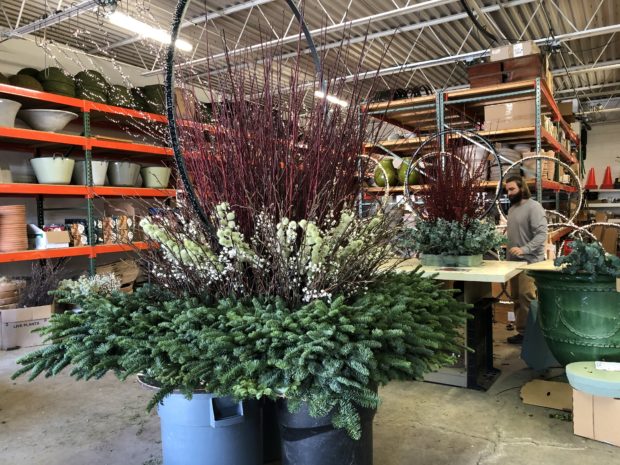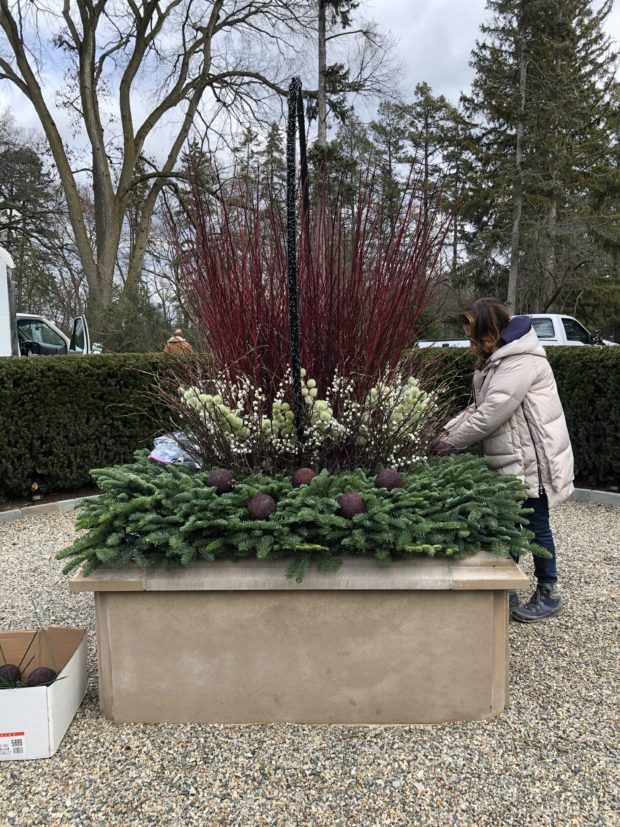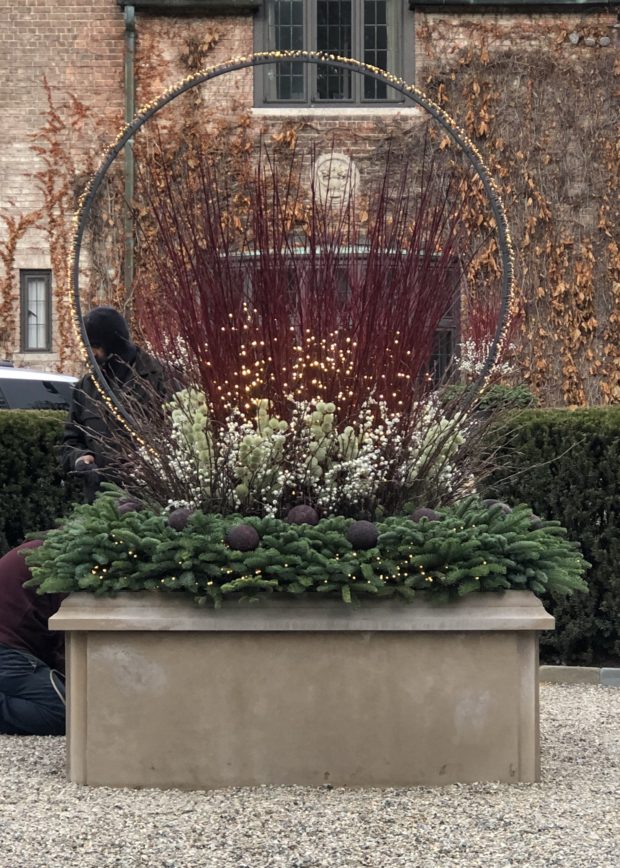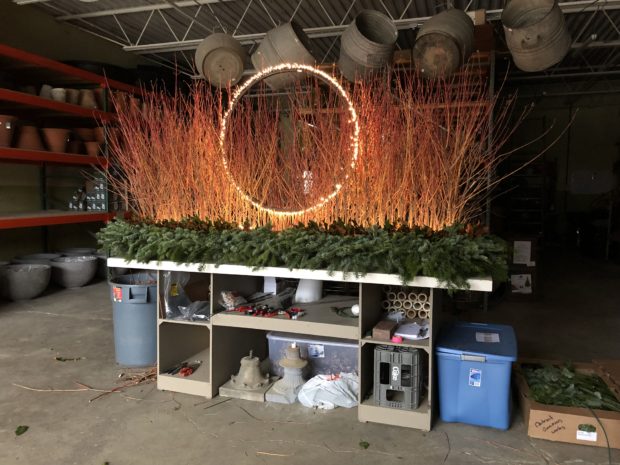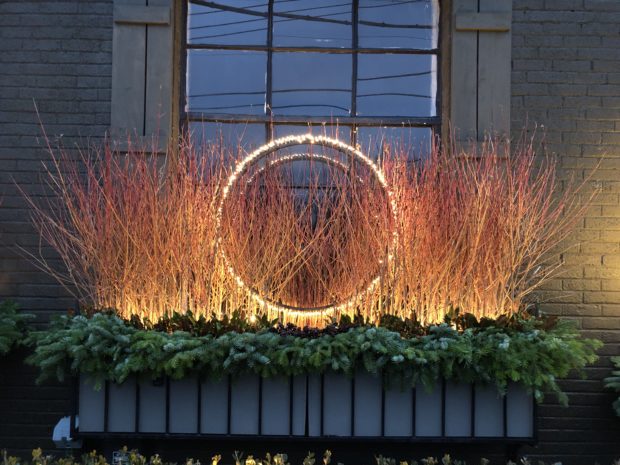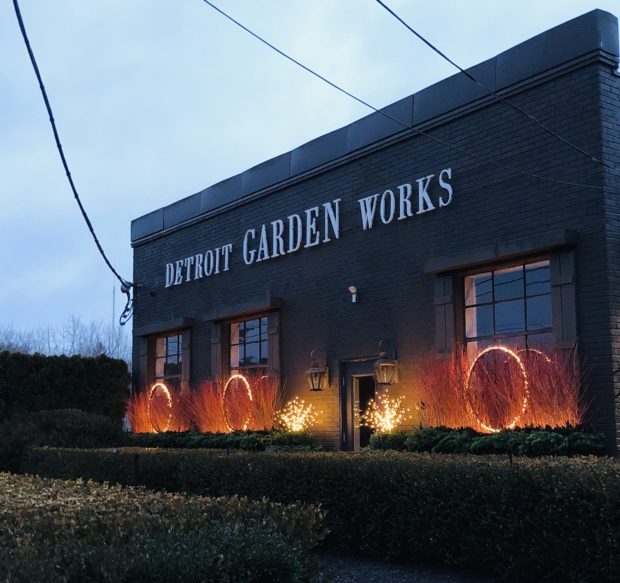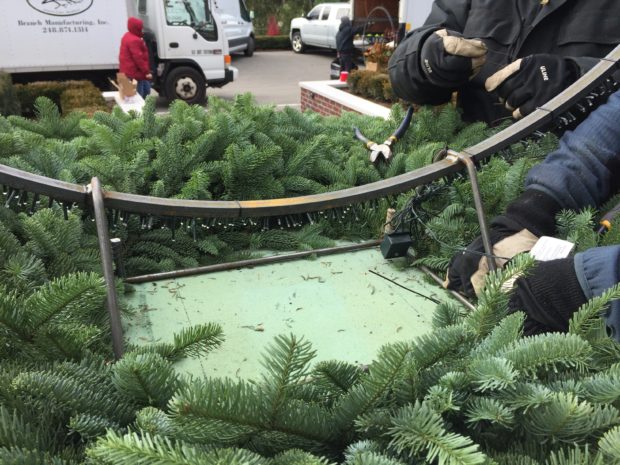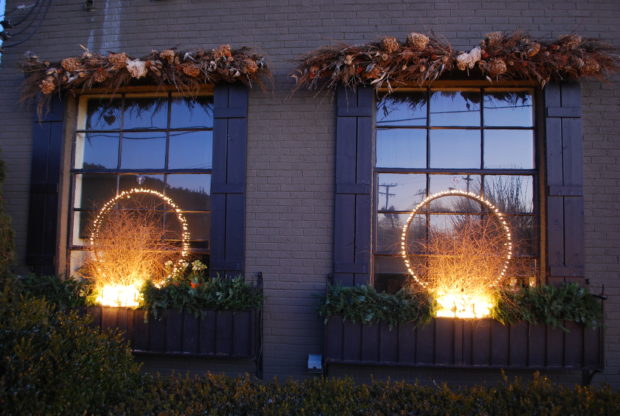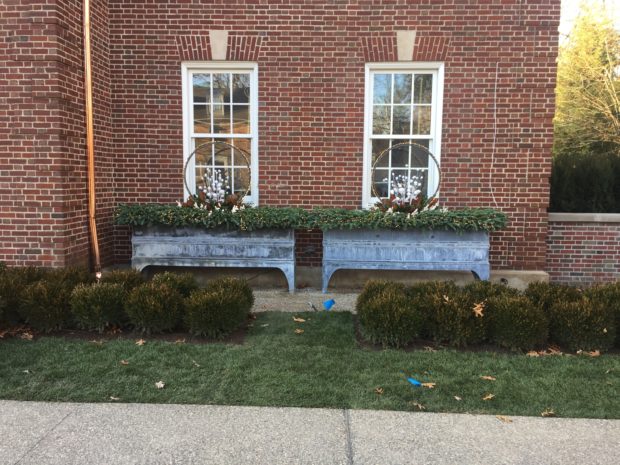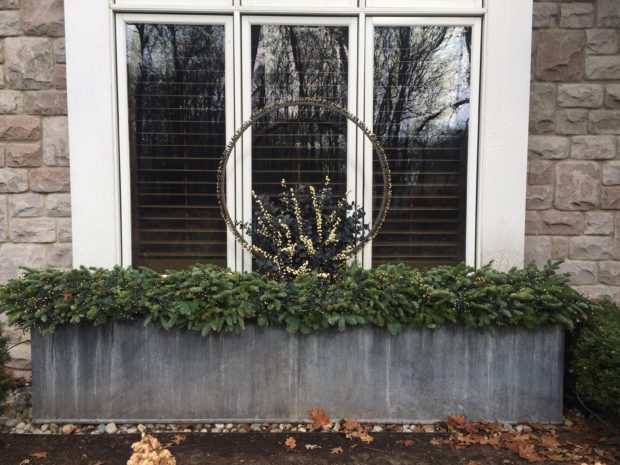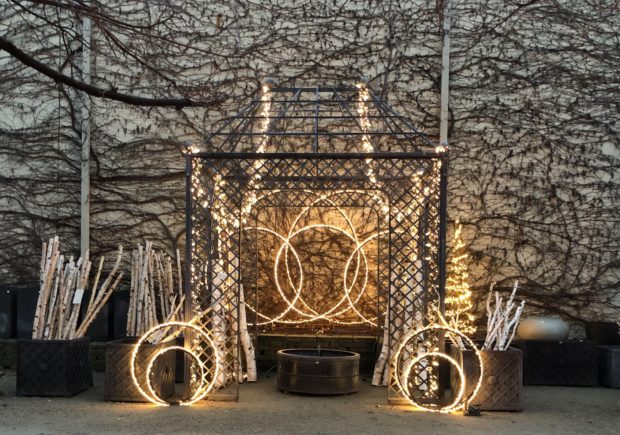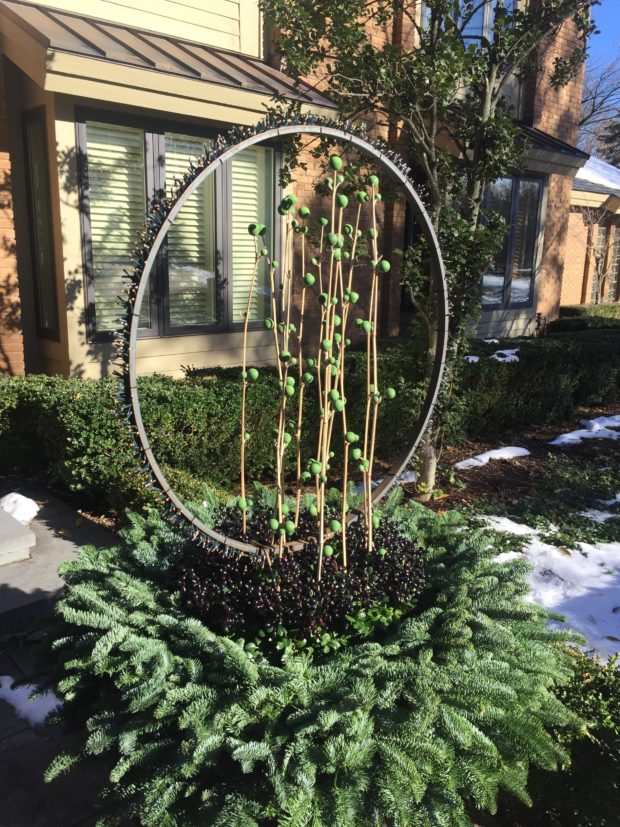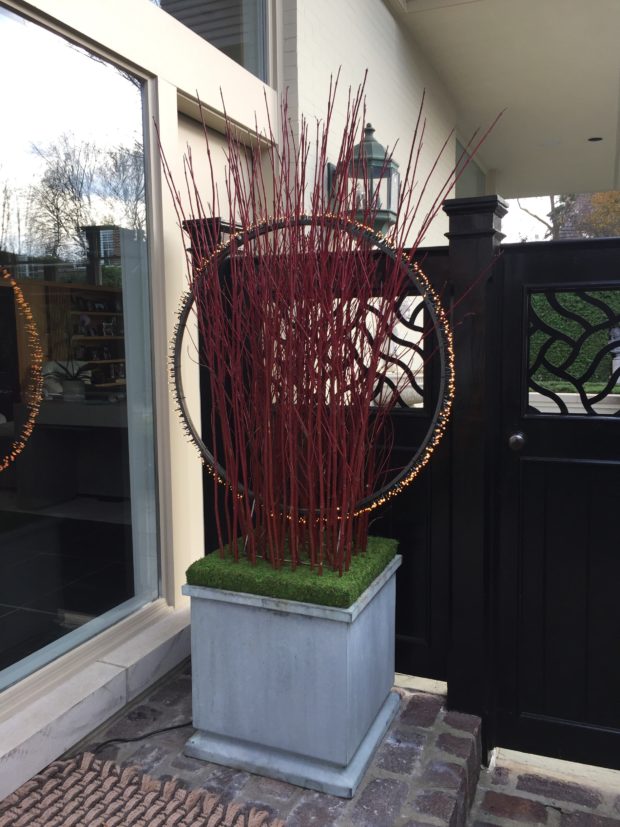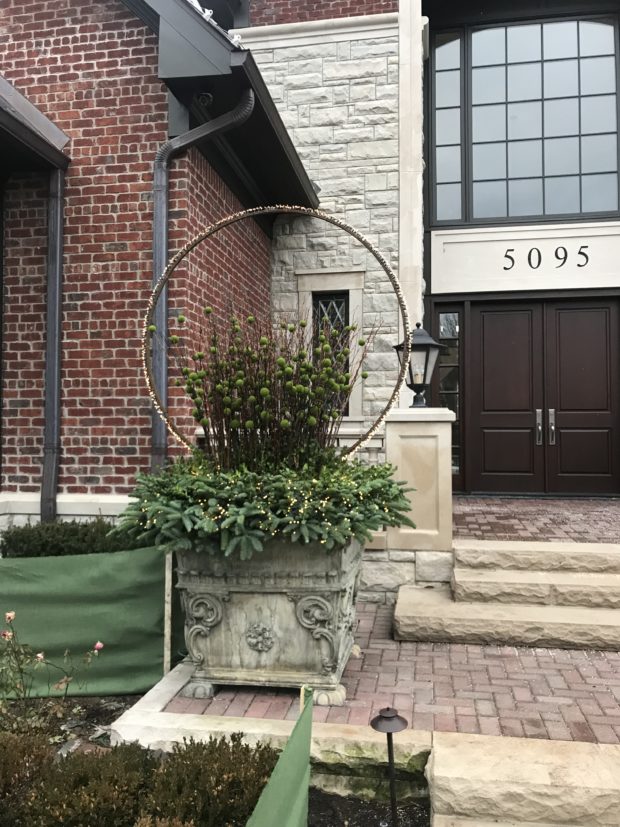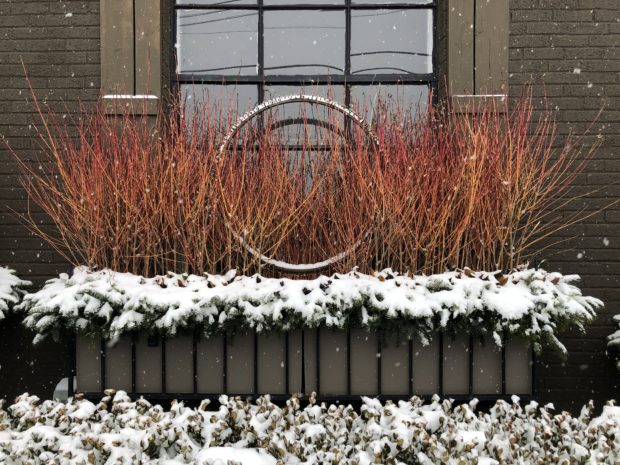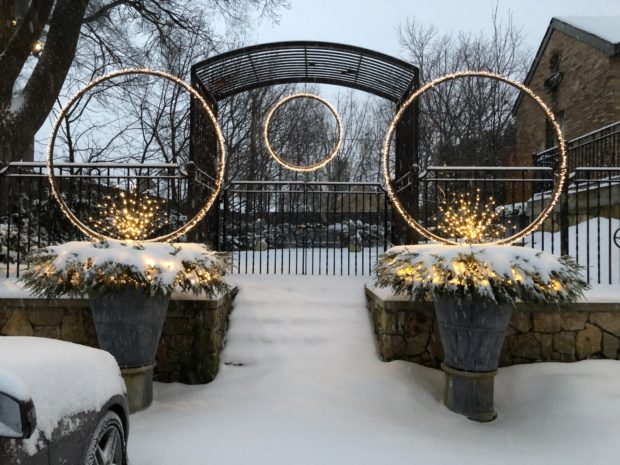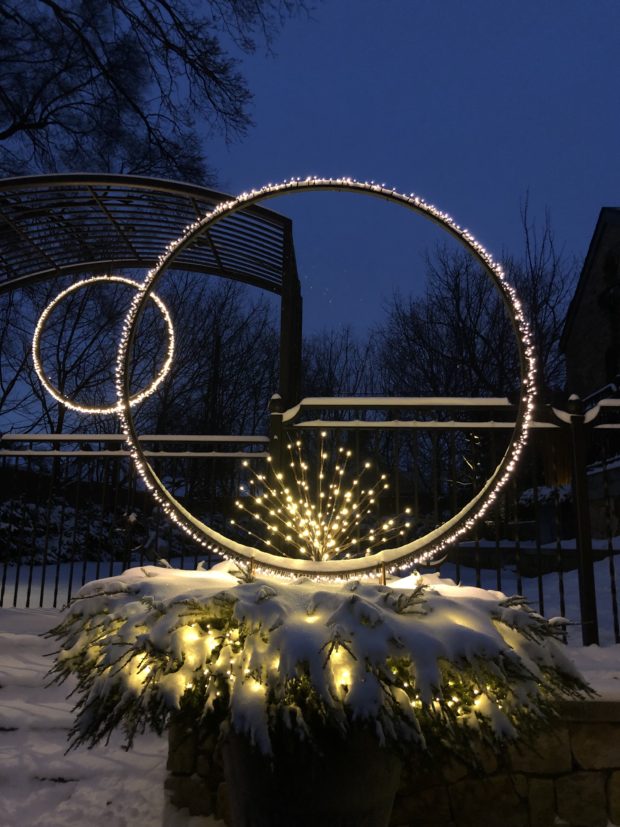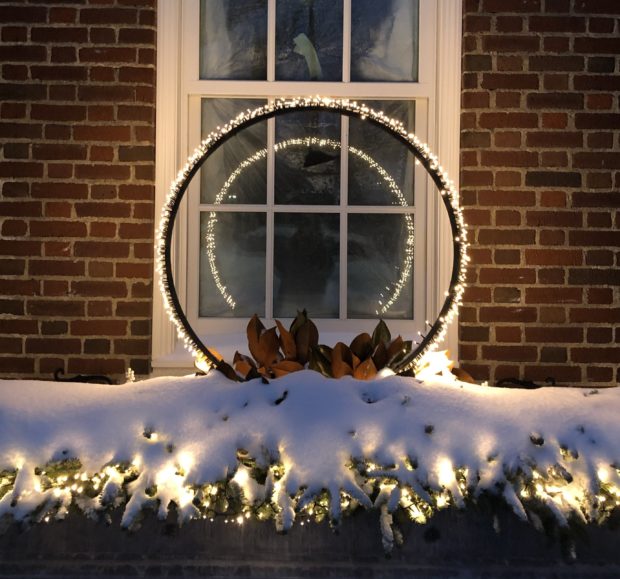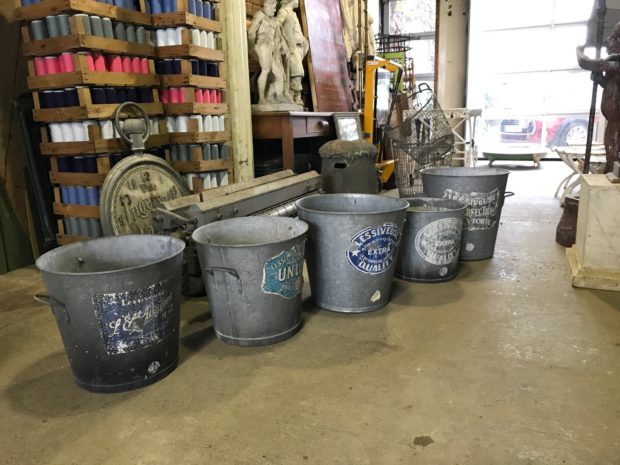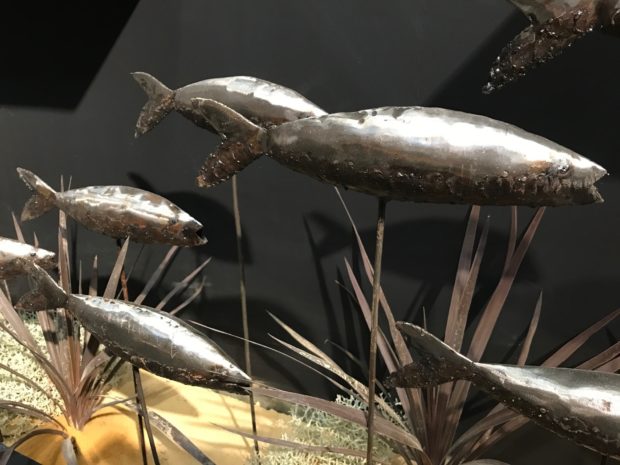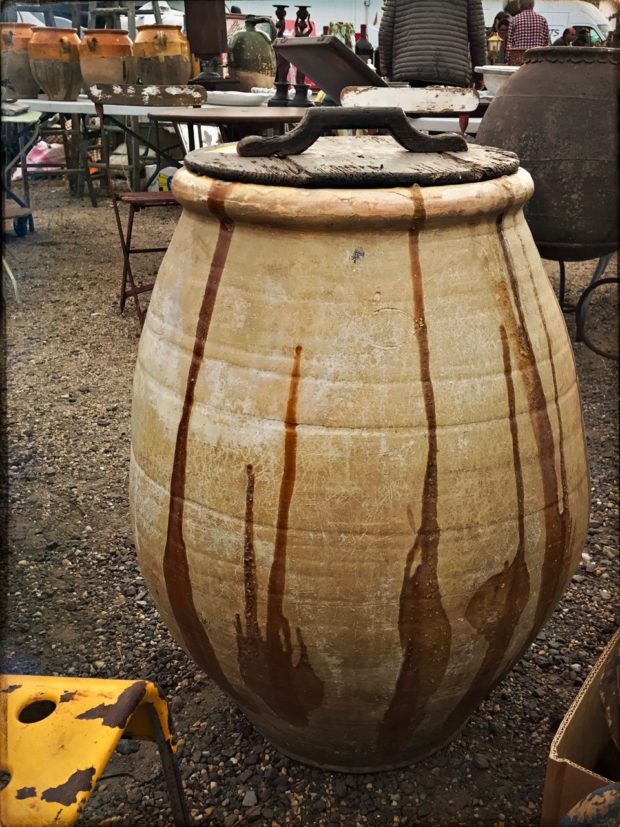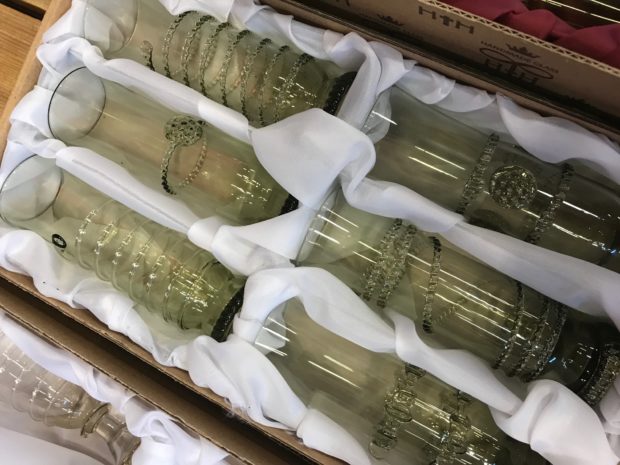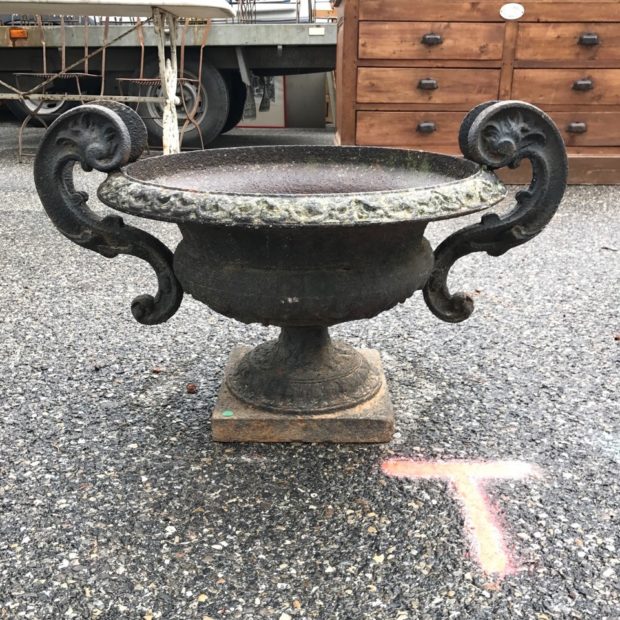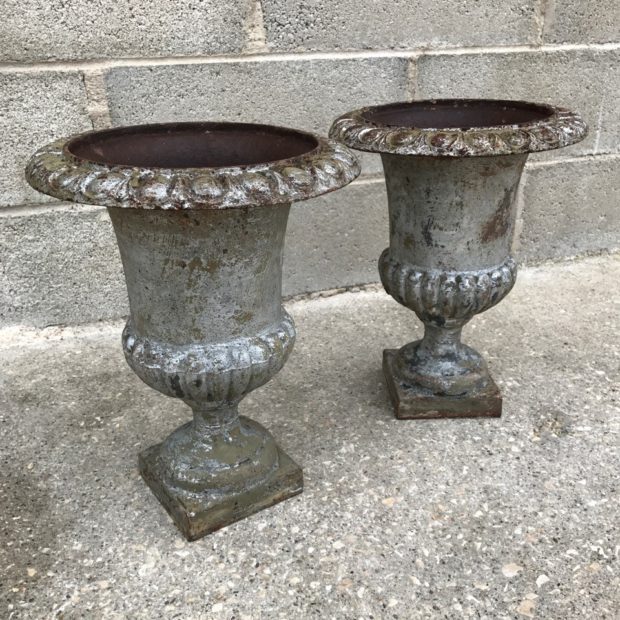 A request to turn a limestone fountain into a container for the winter is not the usual thing, but why not? The dimensions were not overwhelmingly large. Nonetheless, 45″ by 45″ is a lot of territory to cover. The real test would be producing an arrangement of sufficient size to be properly proportional to the container. A fountain, that is. The client was also interested in a substantial lighting plan that would have height, width, and a good deal of intensity. We went for broke with four 140 light count light bursts. The light you see in the above picture would be magnified 20 fold in the dark. Incredible to believe that a lighting device drawing so little power could deliver so much light. And light 3 feet off the surface. Later we added 9 mini light bursts to the mix. Read on for details. The form is 8″ thick-enough to fill the entire watery area of the fountain. And substantial enough to hold a five foot diameter light ring, and hundreds of cut red twig branches, picks, and greens. The hole in the center of the form? This gives the fountain jet a place to be, undisturbed.
A request to turn a limestone fountain into a container for the winter is not the usual thing, but why not? The dimensions were not overwhelmingly large. Nonetheless, 45″ by 45″ is a lot of territory to cover. The real test would be producing an arrangement of sufficient size to be properly proportional to the container. A fountain, that is. The client was also interested in a substantial lighting plan that would have height, width, and a good deal of intensity. We went for broke with four 140 light count light bursts. The light you see in the above picture would be magnified 20 fold in the dark. Incredible to believe that a lighting device drawing so little power could deliver so much light. And light 3 feet off the surface. Later we added 9 mini light bursts to the mix. Read on for details. The form is 8″ thick-enough to fill the entire watery area of the fountain. And substantial enough to hold a five foot diameter light ring, and hundreds of cut red twig branches, picks, and greens. The hole in the center of the form? This gives the fountain jet a place to be, undisturbed.
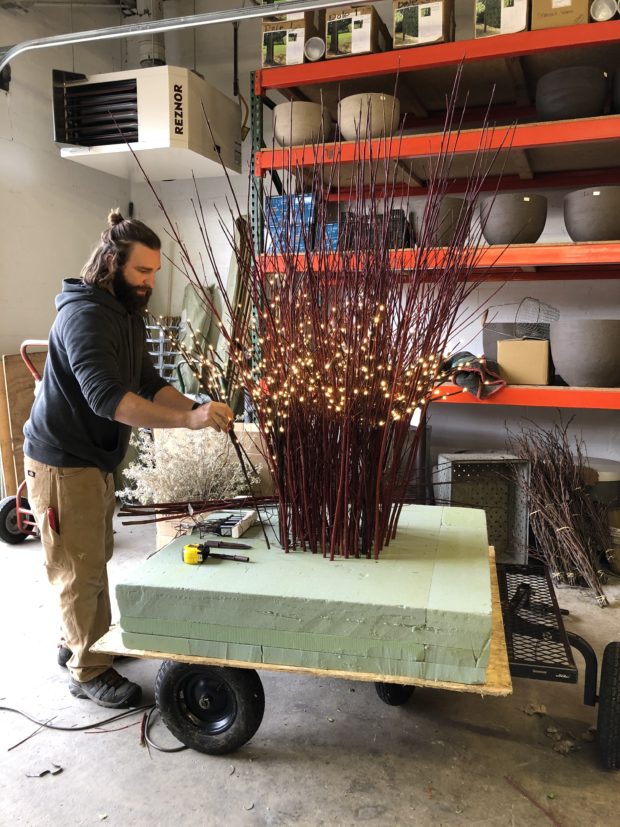 A decision was made about what portion of the form would be twig covered. I do that based on my experience as a landscape designer. Designing landscapes means dealing with space, in all three dimensions. A tape measure and an instinct for proportion is the best I have to offer.
A decision was made about what portion of the form would be twig covered. I do that based on my experience as a landscape designer. Designing landscapes means dealing with space, in all three dimensions. A tape measure and an instinct for proportion is the best I have to offer.
 The red twig dogwood stems at the center would dictate the dimensions of all of the other elements. The light burst would be buried in this forest of twigs. The day time appearance of the arrangement is just as important as what happens after dark. David is particularly skilled at setting cut branches in such a way that the overall shape is natural and graceful. Perfectly shrubby. Perfectly ethereal. Love his work. By this time, the stems of the light bursts are beginning to disappear. He works with the lights on. Doesn’t that make sense?
The red twig dogwood stems at the center would dictate the dimensions of all of the other elements. The light burst would be buried in this forest of twigs. The day time appearance of the arrangement is just as important as what happens after dark. David is particularly skilled at setting cut branches in such a way that the overall shape is natural and graceful. Perfectly shrubby. Perfectly ethereal. Love his work. By this time, the stems of the light bursts are beginning to disappear. He works with the lights on. Doesn’t that make sense?
 A channel has to be created for the prongs and base of the light ring. Some stems are removed, only to be put back in once the ring is in the proper spot. This ring is 5 feet in diameter, and difficult to handle. We like to install it when the arrangement is partially done. We had a branch road map, if you will. It might seem intuitive to install the ring first, and work around it. But that ring is rigidly geometric – not the look we were after for the branches. We make the forest first, and fit that geometric light element into it. Forest first. Always. We could have used a second foam layer for the ring, but I am glad we did not. The ring is at the right height for all of the other elements, sitting in the main form. A second layer of shorter alder branches faced down the red twig. My client and I agreed that the picks she had chosen for the arrangement should be backed up by the more subtly colored alder. A triple layer thicket of alder created a place for the picks to be.
A channel has to be created for the prongs and base of the light ring. Some stems are removed, only to be put back in once the ring is in the proper spot. This ring is 5 feet in diameter, and difficult to handle. We like to install it when the arrangement is partially done. We had a branch road map, if you will. It might seem intuitive to install the ring first, and work around it. But that ring is rigidly geometric – not the look we were after for the branches. We make the forest first, and fit that geometric light element into it. Forest first. Always. We could have used a second foam layer for the ring, but I am glad we did not. The ring is at the right height for all of the other elements, sitting in the main form. A second layer of shorter alder branches faced down the red twig. My client and I agreed that the picks she had chosen for the arrangement should be backed up by the more subtly colored alder. A triple layer thicket of alder created a place for the picks to be.
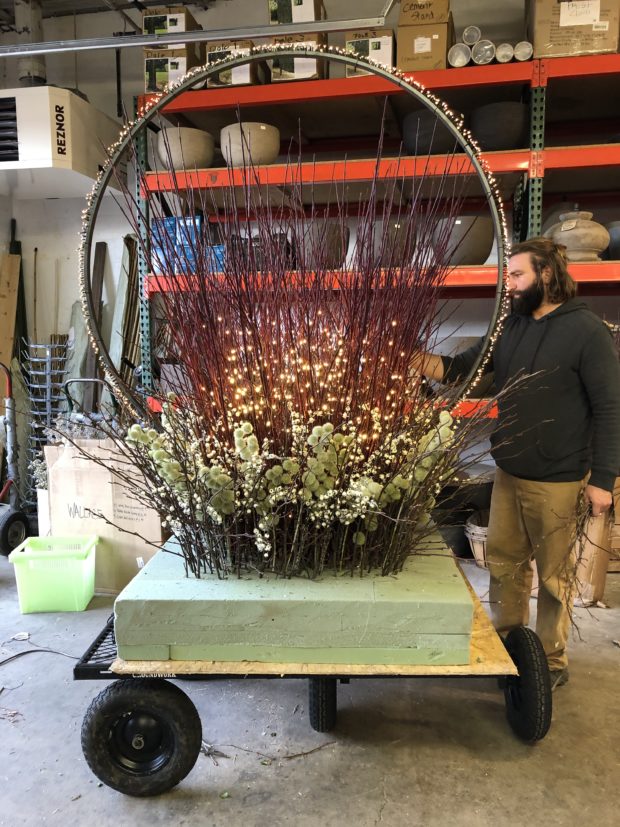 The stems of the faux picks disappear one by one into the alder. The color relationship between the red twig and the picks is made more subtle, given the transition provided by the alder. Fresh cut alder branches are beautiful. The brown bark is punctuated by the green and red tips and buds. The branchy structure of these stems contrast with the mostly vertical red twig stems. The relationship in color, texture and mass between these two twiggy materials is a good one. Any natural twiggy material helps to integrate faux materials into the mix. Sometimes the best element to introduce into a winter arrangement is a little congestion. Some integration. Integrating materials in a winter container requires great skill. A patch of this and a patch of that, all over, can be very hard on the eye.
The stems of the faux picks disappear one by one into the alder. The color relationship between the red twig and the picks is made more subtle, given the transition provided by the alder. Fresh cut alder branches are beautiful. The brown bark is punctuated by the green and red tips and buds. The branchy structure of these stems contrast with the mostly vertical red twig stems. The relationship in color, texture and mass between these two twiggy materials is a good one. Any natural twiggy material helps to integrate faux materials into the mix. Sometimes the best element to introduce into a winter arrangement is a little congestion. Some integration. Integrating materials in a winter container requires great skill. A patch of this and a patch of that, all over, can be very hard on the eye.
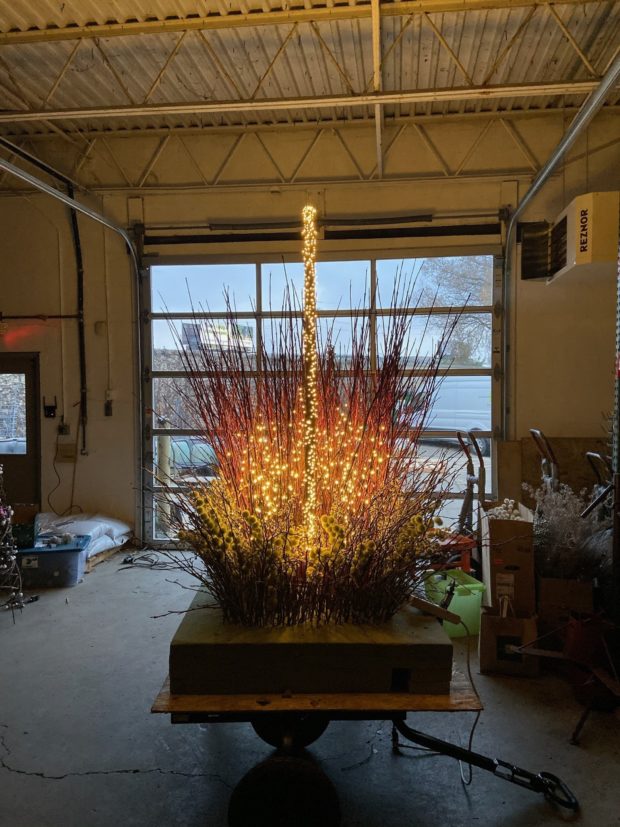 David came in early late this past week to assess how our lighting scheme looked. Four light bursts, and four sets of three mini bursts on the perimeter of the red twig seemed to be creating the light my client was after. The light ring reads strongly.
David came in early late this past week to assess how our lighting scheme looked. Four light bursts, and four sets of three mini bursts on the perimeter of the red twig seemed to be creating the light my client was after. The light ring reads strongly.
 Once I saw this, I knew David had successfully combined a powerfully wide and tall lighting scheme into an integrated arrangement of both fresh cut and faux materials. I doubt I will ever forget this project. Or this picture. The integration of every highly structured element into a gracefully whole expression is a skill that evolves, one project at a time.
Once I saw this, I knew David had successfully combined a powerfully wide and tall lighting scheme into an integrated arrangement of both fresh cut and faux materials. I doubt I will ever forget this project. Or this picture. The integration of every highly structured element into a gracefully whole expression is a skill that evolves, one project at a time.
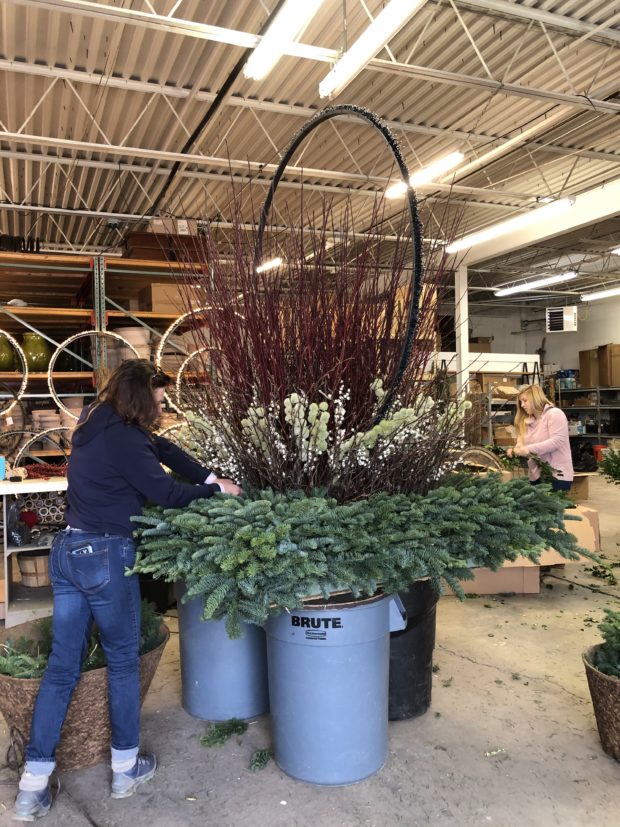 Karen is sticking the last of the greens here.
Karen is sticking the last of the greens here.
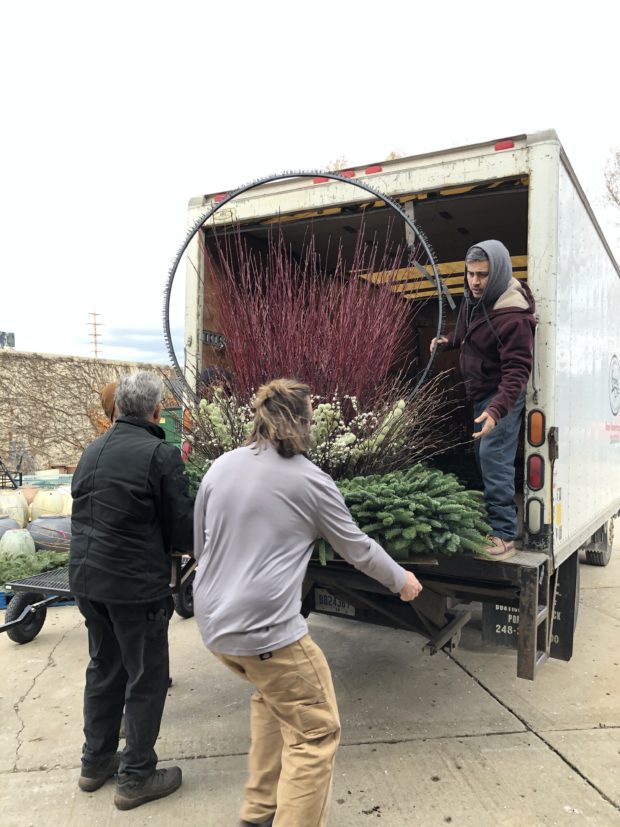 loading the winter arrangement
loading the winter arrangement
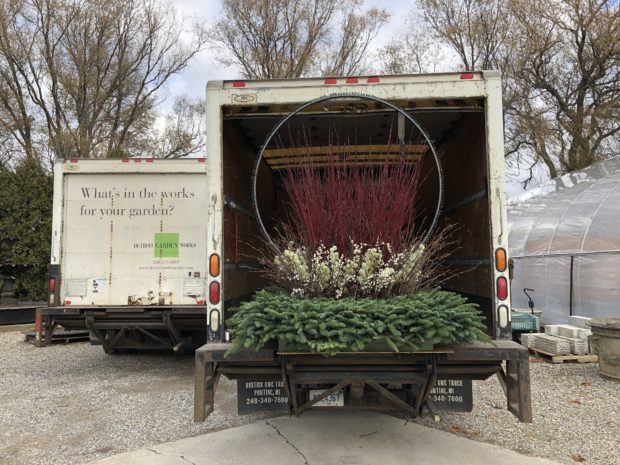 Of course I was not happy that this arrangement did not fit into our box truck. Some landscape person of note one said, “No matter what truck you choose to buy, it will not be big enough”. The box truck did not have a big enough box.
Of course I was not happy that this arrangement did not fit into our box truck. Some landscape person of note one said, “No matter what truck you choose to buy, it will not be big enough”. The box truck did not have a big enough box.
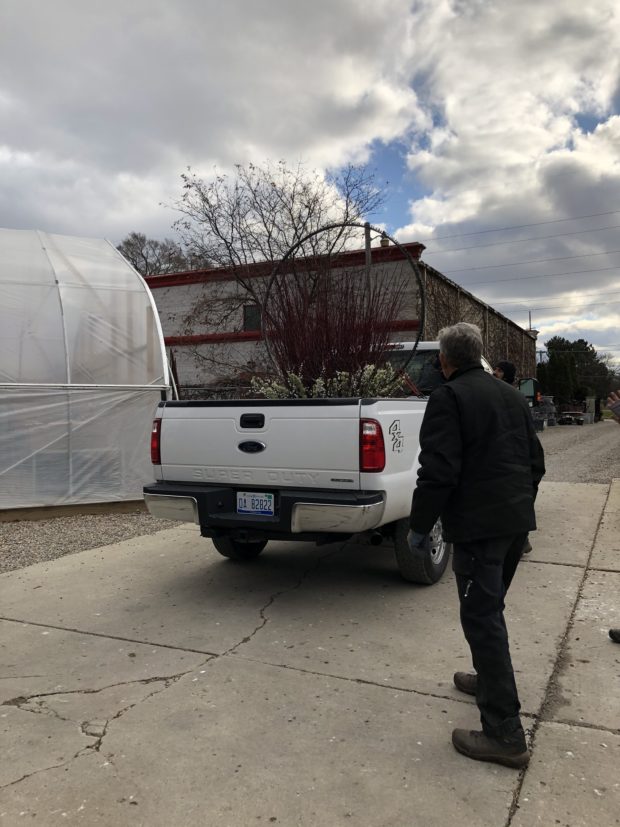 We did eventually load the arrangement into Dan’s pick up truck. I think he was nervous about transporting this arrangement, but he never said so. It was a work day, as usual. Fortunately we did not have far to go.
We did eventually load the arrangement into Dan’s pick up truck. I think he was nervous about transporting this arrangement, but he never said so. It was a work day, as usual. Fortunately we did not have far to go.
 The good and happy end of a project, no matter how small or big, is cause for celebration. Am I celebrating? Yes.
The good and happy end of a project, no matter how small or big, is cause for celebration. Am I celebrating? Yes.
